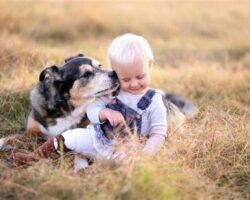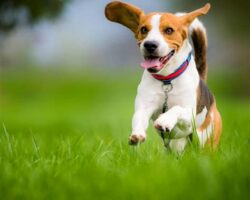Recognizing signs of anxiety in dogs
Recognizing signs of anxiety in dogs is crucial for pet owners to ensure the well-being and happiness of their furry companions. Dogs, just like humans, can experience anxiety and it is important for us to understand and identify these signs in order to provide them with the necessary support and care. By recognizing the signs early on, we can take appropriate steps to alleviate their anxiety and create a safer and more comfortable environment for them.
One of the common signs of anxiety in dogs is excessive barking or howling. When dogs are feeling anxious, they may resort to vocalizing their distress. This can be triggered by various factors such as separation anxiety, fear, or unfamiliar situations. It is important to pay attention to the frequency and intensity of their barking or howling to determine if it is a sign of anxiety or simply a response to external stimuli.
Another sign to watch out for is destructive behavior. Dogs with anxiety may engage in destructive chewing or scratching, particularly when they are left alone. This behavior can be their way of coping with their anxiety or seeking attention and comfort. Finding chew toys or interactive puzzles can help redirect their destructive behavior and provide mental stimulation, ensuring they feel more relaxed and less anxious.
- Excessive barking or howling
- Destructive behavior
- Panting or trembling
- Withdrawal or hiding
- Restlessness or pacing
- Loss of appetite or overeating
| Signs of Anxiety | Description |
|---|---|
| Excessive barking or howling | Dogs may vocalize their distress through excessive barking or howling, often triggered by separation anxiety or fear. |
| Destructive behavior | Anxious dogs may engage in destructive chewing or scratching, particularly when left alone, as a way to cope with their anxiety. |
| Panting or trembling | When dogs are anxious, they may exhibit increased panting or trembling, which can be observed as physical signs of their distress. |
| Withdrawal or hiding | Anxious dogs may withdraw or hide in an attempt to seek safety and distance themselves from anxiety-inducing situations. |
| Restlessness or pacing | Restlessness and pacing are common signs of anxiety in dogs, indicating their inner discomfort and unease. |
| Loss of appetite or overeating | Anxiety can affect a dog’s eating habits, causing a loss of appetite or, in some cases, overeating due to stress. |
Panting or trembling, even in the absence of physical exertion or extreme heat, can also be a sign of anxiety in dogs. Dogs may start panting excessively or trembling when they are anxious or stressed. It is important to consider the context and other accompanying signs to determine if their panting or trembling is anxiety-related.
Withdrawal or hiding is another behavior that may indicate anxiety in dogs. When they feel anxious or overwhelmed, dogs may withdraw or hide in secluded areas of the house or seek out small spaces where they feel safer. Paying attention to these behaviors can help us identify their anxiety triggers and provide the necessary support.
Restlessness or pacing can be observed as signs of anxiety in dogs as well. An anxious dog may not be able to relax or settle down, constantly moving around or pacing back and forth. This behavior shows their inner restlessness and unease, calling for intervention and calming techniques.
Loss of appetite or overeating can also be indicative of anxiety in dogs. Some dogs may lose their appetite when they are anxious, while others may turn to food for comfort and overeat. Monitoring their eating habits and seeking guidance from a veterinarian can help address any underlying anxiety issues that may be affecting their appetite.
In conclusion, recognizing signs of anxiety in dogs is essential for us to provide them with the care and support they need. By being observant and knowledgeable about their behavioral and physical indicators, we can take appropriate measures to alleviate their anxiety and create a safer and more comfortable environment for our beloved furry friends.
Creating a safe and comfortable environment
Creating a safe and comfortable environment for your dog is crucial for their overall well-being and can greatly help in reducing their anxiety. Dogs are highly sensitive creatures and even small changes in their surroundings can affect their emotional state. By providing a safe and comfortable environment, you can help your dog feel secure and minimize their anxiety.
One of the first steps in creating a safe environment for your dog is to ensure that their physical surroundings are secure. This includes making sure that all doors, windows, and gates are properly closed and secured to prevent any potential escape or injury. Additionally, it’s important to remove any hazardous objects or substances that could be harmful to your dog, such as toxic plants, sharp objects, or small items that can be easily swallowed.
Another aspect of creating a safe and comfortable environment for your dog is to provide them with their own designated space where they can retreat to when they feel overwhelmed or anxious. This can be a crate, a specific room, or even a cozy corner with their bed and favorite toys. Having a designated safe space can give your dog a sense of security and provide them with a place where they can relax and unwind.
- Ensure all doors, windows, and gates are secure
- Remove any hazardous objects or substances
- Provide a designated safe space for your dog
- Make sure the temperature and lighting are comfortable
- Keep a consistent daily routine
| Signs of Anxiety | Calming Techniques | Products |
|---|---|---|
| Excessive panting | Deep breathing exercises | Calming pheromone diffusers |
| Pacing and restlessness | Massage or gentle touch | Anxiety wraps or shirts |
| Excessive barking or whining | Music or white noise | Natural calming supplements |
| Destructive behavior | Mindfulness and meditation exercises | Interactive puzzle toys |
Additionally, it’s important to consider the overall atmosphere of your home. Make sure the temperature and lighting are comfortable for your dog, as extreme temperatures or harsh lighting can contribute to their anxiety. Keeping a consistent daily routine can also help create a sense of stability for your dog, as they thrive on predictability and knowing what to expect.
When it comes to creating a safe and comfortable environment for your dog, it’s also crucial to pay attention to their individual needs and preferences. Every dog is unique, and what works for one may not work for another. Take the time to observe your dog’s behavior and body language, and adjust their environment accordingly. By providing a safe and comfortable space for your furry friend, you can help alleviate their anxiety and promote their overall well-being.
Utilizing calming techniques and products
Utilizing Calming Techniques and Products
Anxiety can be a common issue among dogs, and finding ways to help them calm down is essential for their overall well-being. Fortunately, there are various techniques and products available that can be used to provide a sense of comfort and relaxation for your furry friend.
1. Aromatherapy: One effective way to calm an anxious dog is through the use of aromatherapy. Certain scents, such as lavender and chamomile, have calming properties that can help relax your pet. You can utilize essential oils or purchase pet-friendly aromatherapy products specifically designed to ease anxiety.
2. Music Therapy: Music has a soothing effect not only on humans but also on dogs. Playing soft, classical music or specially designed dog relaxation playlists can create a peaceful environment and help alleviate stress. You can easily find such playlists on music streaming platforms or purchase CDs that are specifically composed for calming dogs.
3. Thundershirts: Thundershirts are snug-fitting garments that apply gentle, constant pressure to your dog’s body. This pressure has been shown to have a calming effect on anxious dogs, similar to the sensation of being swaddled. Thundershirts are easy to put on and can provide a sense of security for your pet during times of anxiety.
4. Calming Supplements: There are various natural calming supplements available in the market that can help reduce anxiety in dogs. These supplements usually contain ingredients like chamomile, passionflower, or valerian root, which have natural calming properties. Consult with your veterinarian to determine the most suitable supplement for your dog.
These are just a few examples of the many calming techniques and products that can help alleviate anxiety in dogs. It’s important to remember that every dog is unique, so finding the right method may require some trial and error. By utilizing these techniques and products, you can create a safe and comforting environment for your beloved canine companion.
Positive reinforcement training for fear response
One effective method for addressing a dog’s fear response is through positive reinforcement training. This technique involves rewarding desired behaviors, thereby encouraging the dog to associate positive experiences with the situations that typically trigger fear. Positive reinforcement training can help to build the dog’s confidence and reduce their anxiety levels over time.
There are several key steps to implementing positive reinforcement training for fear response in dogs. First, it is important to identify the specific triggers that cause fear in the dog. This could be certain sounds, objects, or social situations. Once the triggers are recognized, they can be gradually introduced to the dog in a controlled and structured manner.
Next, it is essential to establish a strong foundation of basic obedience commands with the dog. This includes commands such as “sit,” “stay,” and “come.” By teaching the dog these commands and rewarding them for following them, you can establish a sense of trust and communication between you and your pet. This can be particularly helpful in high-stress situations.
- Create a safe and comfortable environment for your dog during training sessions.
- Use treats, praise, and petting as rewards for desired behaviors.
- Gradually expose the dog to the fear triggers in a controlled manner.
- Start with very low-intensity exposures and gradually increase the difficulty level as the dog becomes more comfortable.
- Be patient and understanding, as progress may be slow.
It is important to remember that positive reinforcement training should always be conducted in a gentle and patient manner. Punishment or harsh methods can further exacerbate a dog’s fear response and potentially lead to aggressive behaviors. To ensure the success of positive reinforcement training for fear response, consistency and patience are key.
| Benefits of Positive Reinforcement Training | Drawbacks of Punishment-based Methods |
|---|---|
|
|
Positive reinforcement training for fear response can be a highly effective approach for helping dogs overcome their fears and anxieties. By using rewards and gentle guidance, owners can provide their dogs with a supportive and nurturing environment in which to learn and grow. It is always advisable to consult with a professional dog trainer or behaviorist for further guidance and assistance with implementing positive reinforcement training techniques.
Implementing desensitization and counter-conditioning
Implementing desensitization and counter-conditioning techniques can be incredibly beneficial when helping dogs overcome anxiety and fear. Desensitization involves exposing the dog to the triggers or stimuli that provoke their anxiety in a controlled and gradual manner. By slowly increasing their exposure to the trigger while ensuring they feel safe and relaxed, dogs can become less reactive over time. It is important to note that this process requires patience, consistency, and a thorough understanding of your dog’s triggers and thresholds.
Counter-conditioning, on the other hand, focuses on changing the dog’s emotional response to the trigger from a negative one to a positive or neutral one. This is achieved by pairing the trigger with something the dog finds highly rewarding or pleasurable, such as treats, toys, or praise. By repeatedly associating the trigger with positive experiences, the dog begins to form new and positive associations, ultimately reducing their anxiety response.
One effective way to implement desensitization and counter-conditioning is through the use of a desensitization protocol. This involves breaking down the trigger into small, manageable steps or stages. Starting with a very low-intensity exposure and gradually progressing to more intense or challenging situations, the dog’s anxiety levels are systematically reduced.
- Step 1: Identify the trigger – Whether it’s loud noises, strangers, or car rides, pinpointing the cause of your dog’s anxiety is crucial.
- Step 2: Set achievable goals – Determine small, achievable milestones that you want to reach during the desensitization process.
- Step 3: Create a safe environment – Ensure that the environment is free from stressors and distractions that could hinder progress.
- Step 4: Start small – Begin with a very low-intensity exposure to the trigger, using distance, duration, or intensity as variables to control the level of anxiety.
- Step 5: Use positive reinforcement – During each exposure, reward your dog with treats, toys, and praise to create positive associations with the trigger.
- Step 6: Gradually increase exposure – Slowly increase the intensity or duration of the exposure over time, ensuring your dog remains calm and relaxed throughout.
- Step 7: Monitor progress – Keep track of your dog’s reactions and progress, and make adjustments as necessary.
Remember, implementing desensitization and counter-conditioning techniques should always be done under the guidance of a professional dog trainer or behaviorist. They can provide you with personalized advice, create a customized training plan, and help you navigate any challenges that may arise during the process. With patience, consistency, and the right support, you can help your anxious dog overcome their fears and live a happier, more confident life.
| Benefits of Desensitization and Counter-Conditioning |
|---|
| 1. Reduces Anxiety: Desensitization and counter-conditioning help to decrease the anxiety levels in dogs, allowing them to feel more relaxed in triggering situations. |
| 2. Changes Emotional Response: By associating triggers with positive experiences, dogs can develop new and positive emotional responses, minimizing fear and anxiety. |
| 3. Long-lasting Results: By addressing the root cause of the anxiety and fear response, desensitization and counter-conditioning can lead to long-term behavior changes rather than just temporarily masking the problem. |
| 4. Empowers the Dog: This training technique empowers the dog to overcome their fears by gradually exposing them to triggers in a controlled and safe manner, building confidence along the way. |
| 5. Strengthened Bond: The process of desensitization and counter-conditioning involves a lot of positive reinforcement and rewards, which strengthens the bond between the dog and their owner. |
Seeking professional help for severe anxiety
When it comes to dealing with severe anxiety in dogs, seeking professional help is crucial. While there are various techniques and strategies that can be implemented by dog owners, sometimes the expertise and guidance of a professional is necessary to effectively address the issue. Professional help can provide a comprehensive assessment of the dog’s anxiety and develop an individualized treatment plan.
One of the main benefits of seeking professional help is the expertise and knowledge that professionals bring to the table. They have extensive experience in working with anxious dogs and can accurately diagnose the severity of the anxiety. This is important because severe anxiety may require more intensive treatment approaches and intervention.
Another advantage of professional help is the access to specialized resources and techniques that are not readily available to dog owners. Professionals may use evidence-based strategies such as cognitive-behavioral therapy or medication management to address severe anxiety. They can also provide guidance on modifying the dog’s environment, implementing specific training protocols, and managing triggers that contribute to the anxiety.
- Comprehensive assessment of the dog’s anxiety
- Individualized treatment plan
- Expertise and knowledge of professionals
- Access to specialized resources and techniques
- Evidence-based strategies for severe anxiety
It’s important to understand that seeking professional help does not mean that dog owners have failed. On the contrary, it demonstrates their commitment to their dog’s well-being and willingness to do whatever is necessary to alleviate their anxiety. Professionals can provide ongoing support and guidance throughout the treatment process, making adjustments as needed to ensure progress.
| Benefits of Seeking Professional Help |
|---|
| Expertise and knowledge |
| Access to specialized resources and techniques |
| Comprehensive assessment and individualized treatment plan |
| Ongoing support and guidance |
| Evidence-based strategies for severe anxiety |
Remember that severe anxiety can significantly impact a dog’s quality of life, making professional help an important consideration. With the right support and treatment, dogs can learn to manage their anxiety and lead happier, more relaxed lives.
Preparing for fireworks and thunderstorms in advance
Preparing for fireworks and thunderstorms in advance is essential to ensure the safety and well-being of your dog. Both fireworks and thunderstorms can be incredibly distressing for dogs, causing anxiety and fear. Taking proactive steps to prepare your furry friend for these events can help alleviate their stress and keep them calm. In this blog post, we will explore some effective strategies and tips to help you prepare your dog for fireworks and thunderstorms beforehand.
Recognizing signs of anxiety in dogs
Before we delve into the preparation techniques, it is crucial to understand how anxiety manifests in dogs. Some common signs of anxiety in dogs include trembling, panting excessively, pacing, whining or barking excessively, restlessness, hiding, and seeking constant reassurance. Each dog may display different signs, so it is important to recognize their individual cues for anxiety.
Creating a safe and comfortable environment
One of the first steps in preparing for fireworks and thunderstorms is creating a safe and comfortable environment for your dog. Designate a quiet and secure area in your home where your dog can seek comfort during these events. This can be a basement, a windowless room, or even a cozy crate. Block any windows or doors that may let in flashes of light or loud noises. Provide familiar and comforting items such as their favorite toys, blankets, or even an unwashed piece of clothing with your scent.
Utilizing calming techniques and products
To further ease your dog’s anxiety during fireworks and thunderstorms, consider utilizing calming techniques and products. These can include playing soothing music or white noise to mask the sound of fireworks or storms. You can also try using anxiety wraps or vests that provide gentle pressure and a sense of security for your dog. Additionally, there are various natural supplements and pheromone-based products available in the market that can help relax your dog’s nervous system.
- Make sure to gradually introduce and familiarize your dog with these products and techniques before the actual event.
- Consult with your veterinarian to determine the most suitable options for your dog’s specific needs.
- Remember, every dog is unique, so it may take some trial and error to find what works best for your furry friend.
| Positive Reinforcement Training for Fear Response |
|---|
| Another effective way to prepare your dog for fireworks and thunderstorms is through positive reinforcement training. By building positive associations with these events, you can help your dog develop a more positive response and reduce their fear. Use treats, praise, and rewards to reinforce calm and relaxed behaviors during simulated fireworks or thunderstorm sounds. Gradually increase the intensity of the sounds over time to build resilience and reduce their fear response. |
Implementing desensitization and counter-conditioning
Desensitization and counter-conditioning are two techniques that can be incredibly helpful in preparing your dog for fireworks and thunderstorms. Desensitization involves gradually exposing your dog to the sights and sounds associated with these events at a low level of intensity and gradually increasing over time. Counter-conditioning focuses on changing your dog’s emotional response by pairing the feared stimulus (fireworks or thunderstorms) with positive experiences, such as treats or playtime. These techniques require patience, consistency, and careful planning, so it is advisable to seek guidance from a professional dog trainer or behaviorist.
Seeking professional help for severe anxiety
If your dog experiences severe anxiety or exhibits extreme fear responses during fireworks or thunderstorms, it may be beneficial to seek professional help. A qualified veterinarian, dog behaviorist, or trainer can assess your dog’s condition and develop a personalized plan to address their anxiety. They may recommend additional techniques such as medication, specialized training, or behavior modification exercises to help your dog cope better with these situations.
In conclusion, preparing for fireworks and thunderstorms in advance is crucial to minimize stress and anxiety in dogs. By recognizing the signs of anxiety, creating a safe environment, utilizing calming techniques and products, employing positive reinforcement training, and implementing desensitization and counter-conditioning, you can help your dog feel more comfortable and secure during these challenging events. Remember, each dog is different, so be patient and flexible in finding the approaches that work best for your furry friend.
Frequently Asked Questions
1. How can I recognize signs of anxiety in my dog?
Some common signs of anxiety in dogs include pacing, trembling, excessive barking, panting, excessive licking, and trying to escape. Other signs may include hiding, loss of appetite, and destructive behavior.
2. What can I do to create a safe and comfortable environment for my anxious dog?
To create a safe and comfortable environment, you can provide a designated safe space for your dog, free from loud noises or triggers. Use soothing music or white noise machines to help mask external sounds, and ensure your dog has access to their favorite toys or blankets.
3. Are there any calming techniques or products that can help with my dog’s anxiety?
Calming techniques such as deep pressure therapy, massage, and aromatherapy can help relax an anxious dog. Additionally, products like anxiety wraps, calming pheromone diffusers, and natural supplements may also be beneficial.
4. Can positive reinforcement training help with my dog’s fear response?
Yes, positive reinforcement training can be effective in helping dogs with fear responses. By using rewards and positive reinforcement, you can help build your dog’s confidence and teach them new coping mechanisms.
5. What is desensitization and counter-conditioning, and how can it help my anxious dog?
Desensitization involves gradually exposing your dog to their trigger in a controlled and safe manner, starting with a very low level of intensity, and gradually increasing it over time. Counter-conditioning, on the other hand, involves pairing the trigger with something positive, such as treats or toys, to change your dog’s emotional response to the trigger.
6. When should I seek professional help for my dog’s severe anxiety?
If your dog’s anxiety is severely impacting their quality of life or if you’re struggling to manage their anxiety on your own, it’s important to seek professional help. A veterinarian or a certified dog behaviorist can provide guidance, develop a treatment plan, and recommend medication if necessary.
7. How can I prepare my dog for fireworks and thunderstorms in advance?
To prepare your dog for fireworks and thunderstorms, you can create a safe space for them, use white noise or calming music to mask the sound, and provide distractions like treats or toys. You can also desensitize your dog to the sounds by gradually exposing them to recorded fireworks or thunderstorm noises at a low volume and rewarding them for calm behavior.





